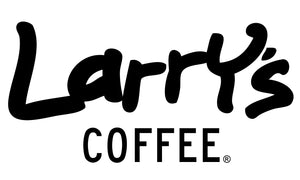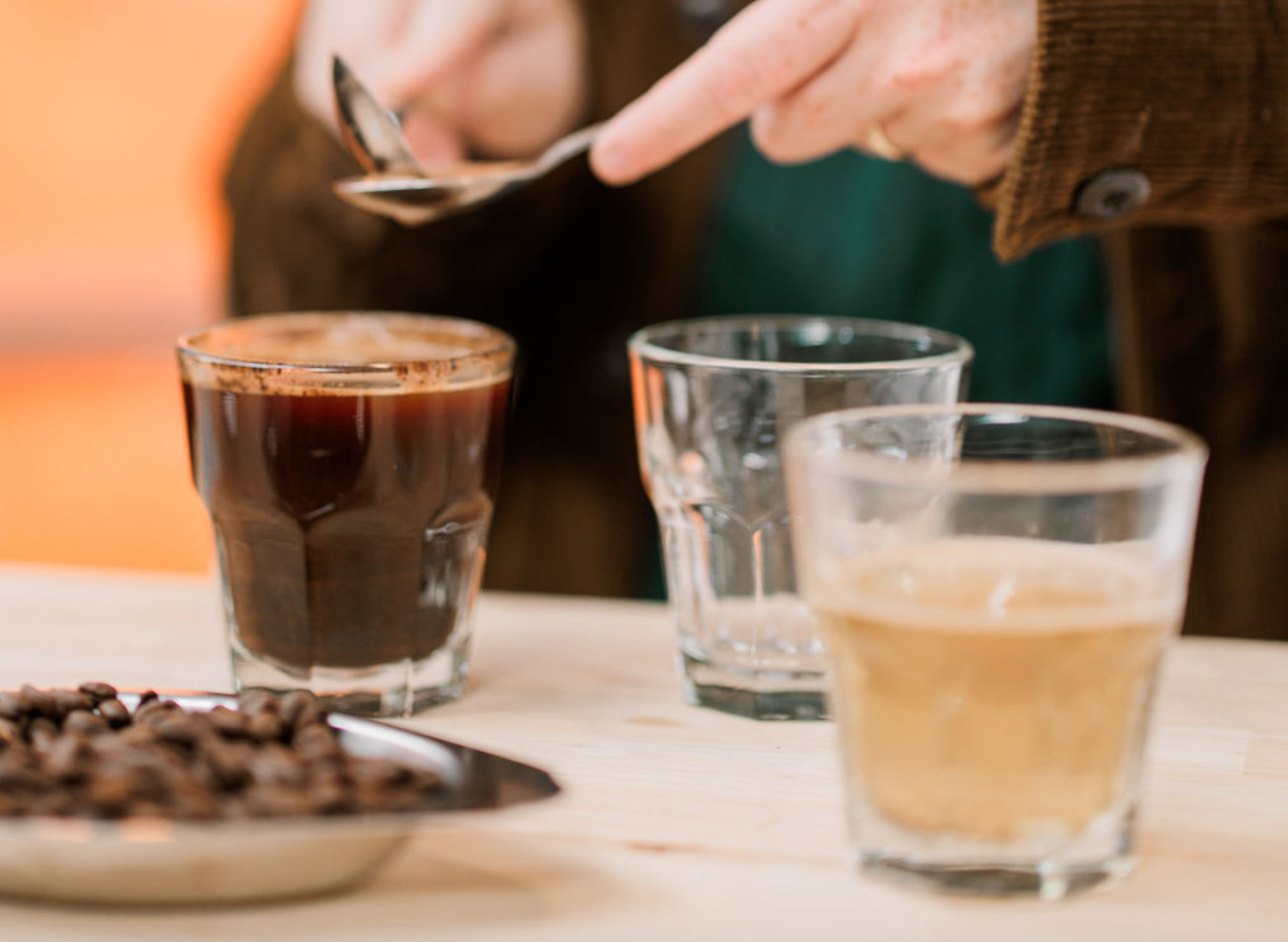FAQ
What makes Larry's Coffee different?
100% of Larry’s Coffee is Organic, Fair Trade and Shade-Grown. Some are also certified "Smithsonian Bird Friendly". As roasters, our goal/obsession is to achieve the most pleasurable balance between the nuanced indigenous flavor intrinsic to the bean and the taste of caramelization notes from the roasting process. Our lighter coffee leans more toward those nuanced indigenous tastes, while our darker roasts push the caramelization a bit more.
No two lots of beans are alike, so we don’t treat them alike. Every time we get a new lot of green coffee (that’s the term for un-roasted beans), we do cupping panels and experimental roasts. If you’re a non-coffee-geek and listened in to one of our tasting panels, you’d hear what would sound like the boring conversation in the world. But it’s utterly stimulating to us. After multiple panels, we dial in the “perfect” setting – and voila!
What brewing ratio should I use?
We are firm believers in the 16:1 ratio. That means for every 16 grams of water you would use 1 gram of coffee. It's also roughly equal to 2 Tbsp for every 6oz of water.
FRENCH PRESS : Add 2 tablespoons of ground coffee to your press, then pour in boiling water (6oz), making sure that all grounds get wet. Wait about 4 minutes, then gently press it down. Enjoy.
DRIP : Larry advises 7-8 level tablespoons for an 8 cup pot.
POUR OVER : Add a filter to your dripper, and add 2 rounded tablespoons of coffee. Pour in boiling water and be sure to get all the grounds wet. When the water has completely drained from the dripper, you are ready to drink up!
COLD BREW : Add cold water and coffee grounded into your brew container. Roughly about 9 cups of water to 1lb of coffee. Its recommended if you add a bit of water, then coffee, then water and so on. Wait 12 hours and filter out. This recipe will give you a cold brew concentrate which you can dilute down with a 3 parts water to 1 part concentrate ratio.
Most of all have fun with it and experiment with different brew methods, grinds, and coffees. Each brew method will bring out a little bit of a different flavor of the bean.
How can I tell when my coffee was roasted?
The 12oz and Kilo bags have printed roast dates on the bottom. For the Bulk bag, there will be a 5 digit number that identifies the roast date. The first two numbers will be the year and the last 3 will be the day of the year. For example 16123 would be May 2, 2016. With May 2 being the 123 day of 2016.
Do you test for any mycotoxins?
We do not do any testing for mycotoxins. The coffee roasting industry does not
routinely test for mycotoxins for there is currently NO reliable and easy method available for measurement.
http://www.ncbi.nlm.nih.gov/pmc/articles/PMC164220/
http://www.vagabondjourney.com/mold-mycotoxins-coffee-and-health-effects/
http://www.food.gov.uk/business-industry/farmingfood/mycotoxins
Does your coffee contain wheat/gluten in the beans? Are they vegan?
No. Coffee is naturally gluten-free.
Veganism is a type of vegetarian diet that excludes meat, eggs, dairy products and all other animal-derived ingredients. Many vegans also do not eat foods that are processed using animal products, such as refined white sugar and some wines.
Our beans DO NOT contain any of the above. There is nothing added when the beans are roasted. So yes, all of our beans are vegan.
Where do your coffee beans come from?
Larry’s Coffee partners with small-farm cooperatives from 16 countries across the globe. Small-farms are technically defined as farms with 20 acres or less, but most farmers Larry’s works with have around 2 to 5 acres.
In the Global coffee market, small-farmers are easily marginalized since they grow in remote regions, they don't have trucks to deliver their coffee themselves and they and lack access to international market prices,, so they tend to take whatever prices they are offered.
“Most small coffee farmers tend to be ‘price-takers’. That means brokers and exporters can easily take advantage of them by setting their prices unreasonably low. Not only is this unfair, but it also prevents roasters and farmers from forming the kinds of long term partnerships that create the best coffee.” -BB
Larry's Beans is a founding member of Cooperative Coffees, the only cooperative of independent roasters that import Fair Trade beans directly from farmers. Cooperative Coffees purveys what Larry (who has long been a board member of the Fair Trade Resource Network) calls "the gold standard of Fair Trade."
All farmers are offered pre-financing and treated as partners, not mere suppliers.
How should I store my coffee?
SHORT ANSWER:
Cool Dark Place: Think air-tight container in a room temperature cabinet. This is ideal for your daily fix.
Freezer: Best for long storage. Think of it like a deep freeze. Once there, stay there. Going back and forth is not good, and for several reasons. But let’s just leave it at that for the moment.
Refrigerator: No to the fridge. The fridge is subject to sharing smells, AND coffee is highly absorbent. Also, the daily temperature change can cause condensation which can break down the coffee’s flavor compounds. It’s too risky to mess with in our opinion.
LONGER ANSWER:
Try this on... Once per week go to the airtight container in the freezer to portion out one week’s worth of coffee. Put that week supply into its own air tight container and stow that in a cool, dark, and dry place. BUT: ya gotta follow this special note or all advice is voided. When you tap into the freezer coffee ya gotta be quick. Get the freezer storage container back into the freezer stat. Like paramedic with a defibrillator. Reason? Condensation. H2O will kill the whole storage gig.
Do you have low- or no-acid coffee options?
First things first- we’re talking pH here, not flavor acidity which is completely unrelated to pH. It is hard to roast coffees and eliminate acid. Typically, the darker roasts have less acidity, but the coffee will not be acid free. The best way reduce a coffee’s natural acidity is to purchase a Cold Water Brewer. It is ideal for people with sensitive stomachs. And the good news- cold brew coffee tastes amazing. Cold brewing produces coffee concentrate which you can use to make hot or iced coffee. We sell cold brew systems on our gadgets webpage [link to page]. How does it work? Cold brewing steeps coarsely ground coffee in cold, fresh water for 16- 24 hours. The grounds are then filtered out and you’re left with liquid concentrate. This concentrate may be stored in the refrigerator for up to six weeks or may be frozen for longer periods. When reconstituted, it becomes a rich, smooth-tasting lower acidity cup of coffee.
Is your decaf coffee chemical free?
YES, all our decaf is water processed and 100% chemical free - and like all our coffee it is 100% Organic. No chemicals are ever used or introduced to any of our coffees, decaf or regular.
Re: Swiss-Water Processing: Early on, Swiss Water Decaf ® was the only option available for maintaining the Organic integrity of the beans. For a long time through patenting they held a virtual monopoly on this type of decaffeination, with the only processing facility located outside of Vancouver. The combination of these two elements made for a hefty added expense, not just in the exclusivity of processing, but also in added round-trip shipping costs and import/export fees. Fortunately (though unfortunate for them), someone dropped the ball on renewing some paperwork which opened the door for competition using the same decaffeination process. These days almost all of Larry's Beans coffees are processed using the nearly identical Water Process by a company called DESCAMEX in Mexico. Not only is pricing more competitive, but the carbon footprint of shipping is significantly reduced - and we love that! Here is a YouTube video which demonstrates the process. This explanation is definitely not as cool as Swiss Water's website, though it is nearly the exact same process. Occasionally we will roast a "lot" of coffee which is Swiss Water processed, but almost entirely these days, our coffees are Water Processed from DESCAMEX. Rest assured that no chemicals are ever used in decaffeinating our coffee!
How much caffeine is left in decaf coffee?
Unfortunately, all decaf coffee contains some traces of caffeine. It's extremely difficult to remove every last bit of caffeine from coffee because of how important it is to the coffee plant on a molecular level-caffeine is coffee's natural defense against insects.
Studies show that the decaffeination process usually removes around 90% of the caffeine from the bean, give or take. So while an 8 oz cup of regular coffee would have about 85 mg of caffeine in it, an 8 oz cup of decaf would have about 8-10 mg of caffeine. That means you would have to drink 10 cups of decaf to equal one cup of regular coffee.
Which grind do you recommend for a K-Cup?
We recommend somewhere between an espresso grind and a cone drip grind.
Get in touch
Have questions about your order, or a general inquiry?
Email us at: Support@larryscoffee.com
Phone - (919) 828-1234
Address:
1507 Gavin street
Raleigh, NC 27608
Hours:
M-F 9:00-5:30pm
Saturday: 9:00a-12:00p (November through December)

